Release 2 (8.1.6)
Part Number A76965-01
Library |
Product |
Contents |
Index |
| Oracle8i Concepts Release 2 (8.1.6) Part Number A76965-01 |
|
This chapter explains the basic concepts and terminology behind Oracle replication. This chapter covers the following topics:
Replication is the process of copying and maintaining database objects, such as tables, in multiple databases that make up a distributed database system. Changes applied at one site are captured and stored locally before being forwarded and applied at each of the remote locations. Oracle replication is a fully integrated feature of the Oracle server; it is not a separate server.
Replication uses distributed database technology to share data between multiple sites, but a replicated database and a distributed database are not the same. In a distributed database, data is available at many locations, but a particular table resides at only one location. For example, the EMP table might reside at only the DB1 database in a distributed database system that also includes the DB2 and DB3 databases. Replication means that the same data is available at multiple locations. For example, the EMP table might be available at DB1, DB2, and DB3.
Some of the common reasons for using replication are:
You will find more detailed descriptions of the uses of replication in later chapters.
Replication supports a variety of applications that often have different requirements. Some applications allow for relatively autonomous individual snapshot sites. For example, sales force automation, field service, retail, and other mass deployment applications typically require data to be periodically synchronized between central database systems and a large number of small, remote sites, which are often disconnected from the central database. Members of a sales force must be able to complete transactions, regardless of whether they are connected to the central database. In this case, remote sites must be autonomous.
On the other hand, applications such as call centers and Internet systems require data on multiple servers to be synchronized in a continuous, nearly instantaneous manner to ensure that the service provided is available and equivalent at all times. For example, a retail web site on the Internet must ensure that customers see the same information in the online catalog at each site. Here, data consistency is more important than site autonomy.
Oracle replication can be used for both types of applications, and for applications that combine aspects of both. In fact, one Oracle replication environment can support both mass deployment and server-to-server replication, which enables integration into one coherent environment. In such an environment, for example, sales force automation and customer service call centers can share data.
The following sections explain the basic components of a replication system, including replication objects, replication groups, and replication sites.
A replication object is a database object existing on multiple servers in a distributed database system. In a replication environment, any updates made to a replication object at one site are applied to the copies at all other sites. Oracle replication enables you to replicate the following types of objects:
In a replication environment, Oracle manages replication objects using replication groups. A replication group is a collection of replication objects that are logically related. The objects in a replication group are administered together.
By organizing related database objects within a replication group, it is easier to administer many objects together. Typically, you create and use a replication group to organize the schema objects necessary to support a particular database application. However, replication groups and schemas do not need to correspond with one another. A replication group can contain objects from multiple schemas, and a single schema can have objects in multiple replication groups. However, a replication object can be a member of only one replication group.
A replication group can exist at multiple replication sites. Replication environments support two basic types of sites: master sites and snapshot sites. One site can be both a master site and a snapshot site at the same time.
The differences between master sites and snapshot sites are:
Oracle replication supports the following types of replication environments:
Multimaster replication (also called peer-to-peer or n-way replication) allows multiple sites, acting as equal peers, to manage groups of replicated database objects. Each site in a multimaster replication environment is a master site.
Applications can update any replicated table at any site in a multimaster configuration. Oracle database servers operating as master sites in a multimaster environment automatically work to converge the data of all table replicas and to ensure global transaction consistency and data integrity.
Asynchronous replication is the most common way to implement multimaster replication. Other ways include synchronous replication and procedural replication, which are discussed later in this chapter. When you use asynchronous replication, an update of a table is stored in the deferred transactions queue at the master site where the change occurred. These changes are called deferred transactions. The deferred transactions are pushed (or propagated) to the other participating master sites at regular intervals. You can control the amount of time in an interval.
Using asynchronous replication means that conflicts are possible because the same row value might be updated at two different master sites at nearly the same time. However, you can use techniques to avoid conflicts and, if conflicts occur, Oracle provides built-in mechanisms to resolve them.
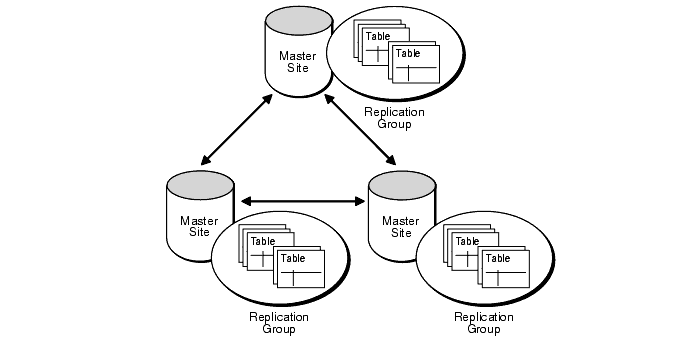
At times, you must stop all replication activity for a master group so that you can perform certain administrative tasks on the master group. For example, you must stop all replication activity for a master group to issue data definition language (DDL) statements on any table in the group. Stopping all replication activity for a master group is called quiescing the group. When a master group is quiesced, users cannot perform data manipulation language (DML) statements on any of the objects in the master group.
A snapshot contains a complete or partial copy of a target master table from a single point in time. A snapshot may be read-only or updateable.
All snapshots provide the following benefits:
In a basic configuration, snapshots can provide read-only access to the table data that originates from a master site. Applications can query data from read-only snapshots to avoid network access regardless of network availability. However, applications throughout the system must access data at the master site to perform an update. Figure 31-2 illustrates basic, read-only replication. The master tables of read-only snapshots do not need to belong to a master group.
Read-only snapshots provide the following benefits:
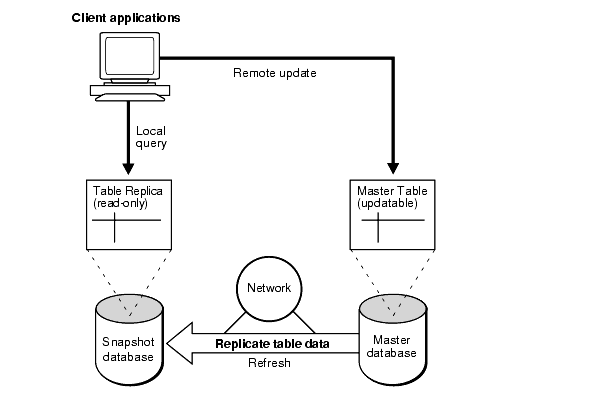
In a more advanced configuration, you can create an updatable snapshot that allows users to insert, update, and delete rows of the target master table by performing these operations on the snapshot. An updatable snapshot may also contain only a subset of the data in the target master table. Figure 31-3 illustrates a replication environment using updatable snapshots.
Updatable snapshots are based on tables at a master site that have been set up to support replication. In fact, updatable snapshots must be part of a snapshot group that is based on a master group at a master site.
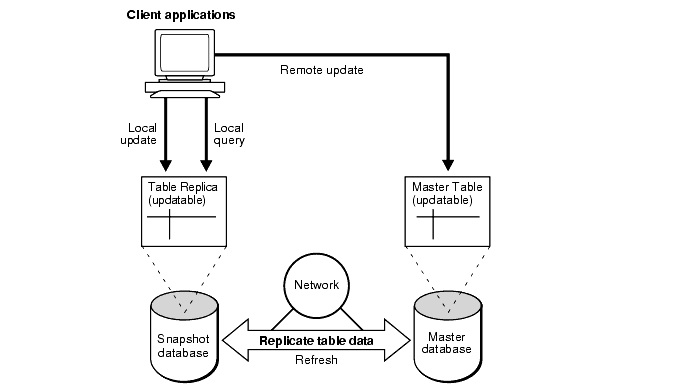
Updatable snapshots have the following properties.
Updatable snapshots provide the following benefits:
To ensure that a snapshot is consistent with its master table, you need to refresh the snapshot periodically. Oracle provides the following three methods to refresh snapshots:
When it is important for snapshots to be transactionally consistent with each other, you can organize them into refresh groups. By refreshing the refresh group, you can ensure that the data in all of the snapshots in the refresh group correspond to the same transactionally consistent point in time. A snapshot in a refresh group still can be refreshed individually, but doing so nullifies the benefits of the refresh group because refreshing the snapshot individually does not refresh the other snapshots in the refresh group.
A snapshot log is a table that records all of the DML changes to a master table. A snapshot log is associated with a single master table, and each master table has only one snapshot log, regardless of how many snapshots refresh from the master. A fast refresh of a snapshot is possible only if the snapshot's master table has a snapshot log. When a snapshot is fast refreshed, entries in the snapshot's associated snapshot log that have appeared since the snapshot was last refreshed are applied to the snapshot.
Deployment templates simplify the task of deploying and maintaining many remote snapshot sites. Using deployment templates, you can define a collection of snapshot definitions at a master site, and you can use parameters in the definitions so that the snapshots can be customized for individual users or types of users.
For example, you might create one template for the sales force and another template for field service representatives. In this case, a parameter value might be the sales territory or the customer support level. When a remote user connects to a master site, the user sees a list of available templates. When the user instantiates a template, the appropriate snapshots are created and populated at the remote site. The appropriate parameter values can either be supplied by the remote user or taken from a table maintained at the master site.
When a user instantiates a template at a snapshot site, the object DDL (for example, CREATE SNAPSHOT... or CREATE TABLE...) is executed to create the appropriate schema objects at the snapshot site, and the objects are populated with the appropriate data.
Users can instantiate templates while connected to the master site over a network (online instantiation), or while disconnected from the master site (offline instantiation).
Offline instantiation is often used to decrease server loads during peak usage periods and to reduce remote connection times. To instantiate a template offline, you package the template and required data on some type of storage media, such as tape, CD-ROM, and so on. Then, instead of pulling the data from the master site, users pull the data from the storage media containing the template and data.
Multimaster replication and snapshots can be combined in hybrid or "mixed" configurations to meet different application requirements. Mixed configurations can have any number of master sites and multiple snapshot sites for each master.
For example, as shown in Figure 31-4, multimaster (or n-way) replication between two masters can support full-table replication between the databases that support two geographic regions. Snapshots can be defined on the masters to replicate full tables or table subsets to sites within each region.
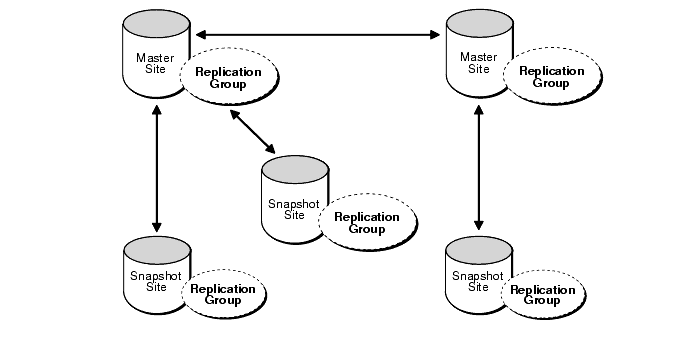
Key differences between snapshots and replicated masters include the following:
Several tools are available for administering and monitoring your replication environment. Oracle's Replication Manager provides a powerful GUI interface to help you manage your environment, while the replication management API provides you with the familiar application programming interface (API) to build customized scripts for replication administration. Additionally, the replication catalog keeps you informed about your replicated environment.
Replication environments supporting both multimaster and snapshot replication can be challenging to configure and manage. To help administer these replication environments, Oracle provides a sophisticated management tool called Oracle Replication Manager. Other sections in this book include information and examples for using Replication Manager. However, the Replication Manager online help is the primary documentation source for Replication Manager.
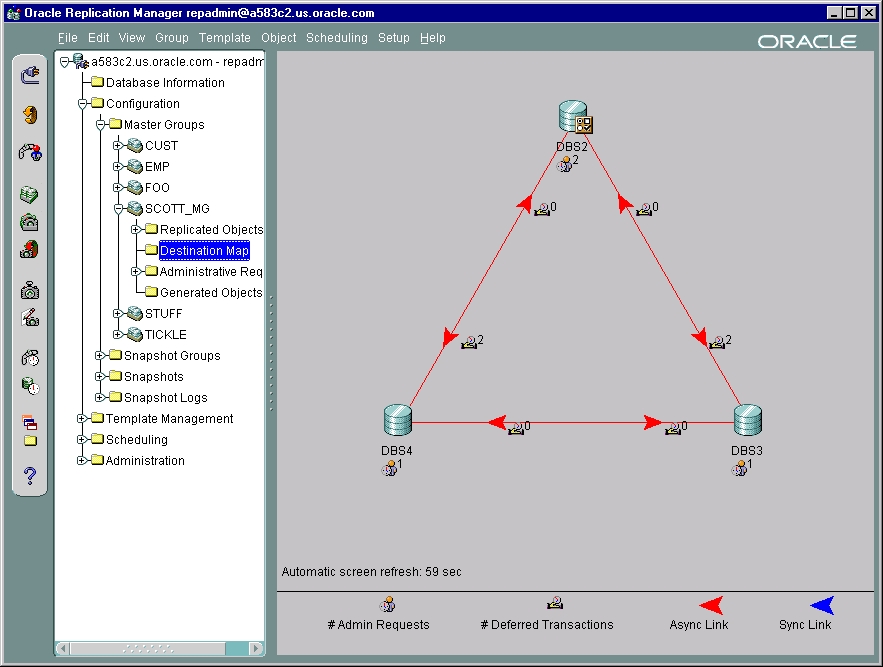
|
See Also:
Oracle8i Replication for an introduction to Replication Manager, and see the Replication Manager online help for complete instructions on using Replication Manager. |
The replication management application programming interface (API) is a set of PL/SQL packages that encapsulate procedures and functions that you can use to configure an Oracle replication environment. The replication management API is a command-line alternative to Replication Manager. In fact, Replication Manager uses the procedures and functions of the replication management API to perform its work. For example, when you use Replication Manager to create a new master group, Replication Manager completes the task by making a call to the DBMS_REPCAT.CREATE_MASTER_REPGROUP procedure. The replication management API makes it easy for you to create custom scripts to manage your replication environment.
|
See Also:
Oracle8i Replication Management API Reference for more information about using the replication management API. |
Every master and snapshot site in a replication environment has a replication catalog. A replication catalog for a site is a distinct set of data dictionary tables and views that maintain administrative information about replication objects and replication groups at the site. Every server participating in a replication environment can automate the replication of objects in replication groups using the information in its replication catalog.
|
See Also:
Oracle8i Replication Management API Reference for more information about the replication catalog. |
In a replication environment, all DDL statements must be issued using either Replication Manager or the DBMS_REPCAT package. When you use either of these interfaces, all DDL statements are replicated to all of the sites participating in the replication environment.
Asynchronous multimaster and updateable snapshot replication environments must address the possibility of replication conflicts that may occur when, for example, two transactions originating from different sites update the same row at nearly the same time. When data conflicts occur, you need a mechanism to ensure that the conflict is resolved in accordance with your business rules and to ensure that the data converges correctly at all sites.
In addition to logging any conflicts that may occur in your replicated environment, Oracle replication offers a variety of built-in conflict resolution methods that enable you to define a conflict resolution system for your database that resolves conflicts in accordance with your business rules. If you have a unique situation that Oracle's built-in conflict resolution methods cannot resolve, you have the option of building and using your own conflict routines.
|
See Also:
|
Asynchronous replication is the most common way to implement multimaster replication. However, you have two other options: synchronous replication and procedural replication.
A multimaster replication environment can use either asynchronous or synchronous replication to copy data. With asynchronous replication, changes made at one master site occur at a later time at all other participating master sites. With synchronous replication, changes made at one master site occur immediately at all other participating master sites.
When you use synchronous replication, an update of a table results in the immediate replication of the update at all participating master sites. In fact, each transaction includes all master sites. Therefore, if one master site cannot process a transaction for any reason, the transaction is rolled back at all master sites.
Although you avoid the possibility of conflicts when you use synchronous replication, it requires a very stable environment to operate smoothly. If communication to one master site is not possible because of a network problem, for example, no transactions can be completed until communication is re-established.
Batch processing applications can change large amounts of data within a single transaction. In such cases, typical row-level replication might load a network with many data changes. To avoid such problems, a batch processing application operating in a replication environment can use Oracle's procedural replication to replicate simple stored procedure calls to converge data replicas. Procedural replication replicates only the call to a stored procedure that an application uses to update a table. It does not replicate the data modifications themselves.
To use procedural replication, you must replicate the packages that modify data in the system to all sites. After replicating a package, you must generate a wrapper for the package at each site. When an application calls a packaged procedure at the local site to modify data, the wrapper ensures that the call is ultimately made to the same packaged procedure at all other sites in the replicated environment. Procedural replication can occur asynchronously or synchronously.
When a replication system replicates data using procedural replication, the procedures that replicate data are responsible for ensuring the integrity of the replicated data. That is, you must design such procedures to either avoid or detect replication conflicts and to resolve them appropriately. Consequently, procedural replication is most typically used when databases are modified only with large batch operations. In such situations, replication conflicts are unlikely because numerous transactions are not contending for the same data.
|
|
 Copyright © 1996-2000, Oracle Corporation. All Rights Reserved. |
|